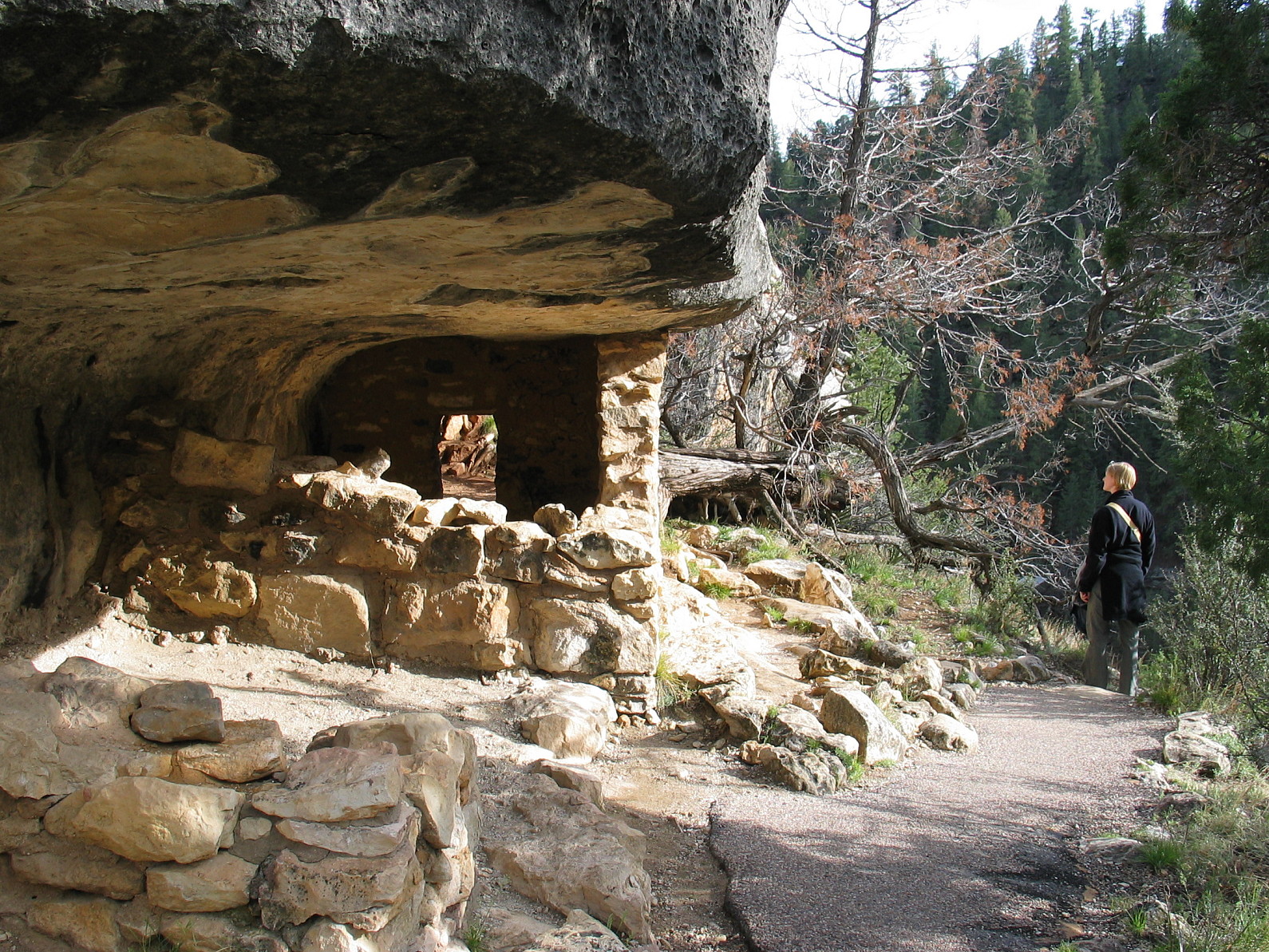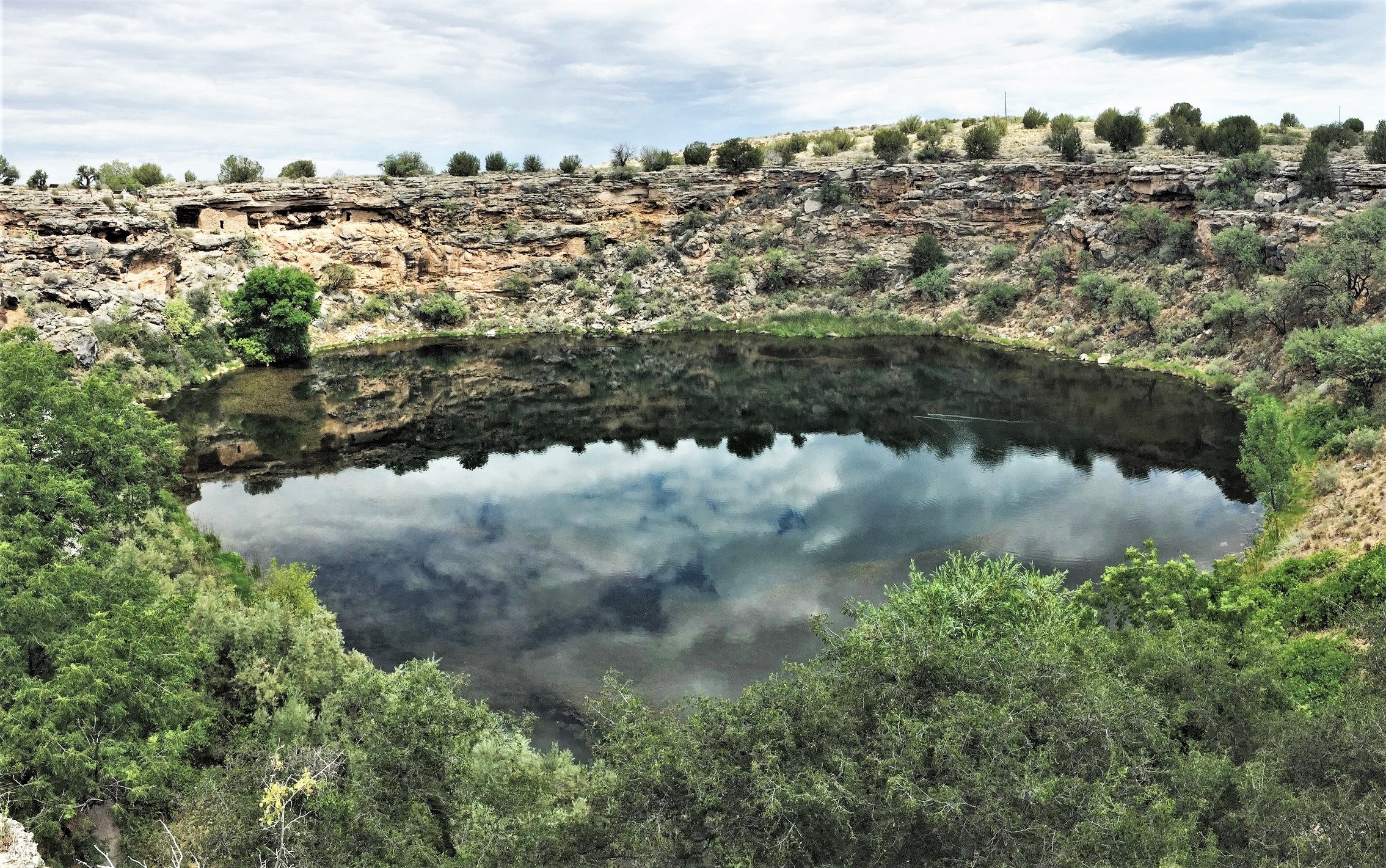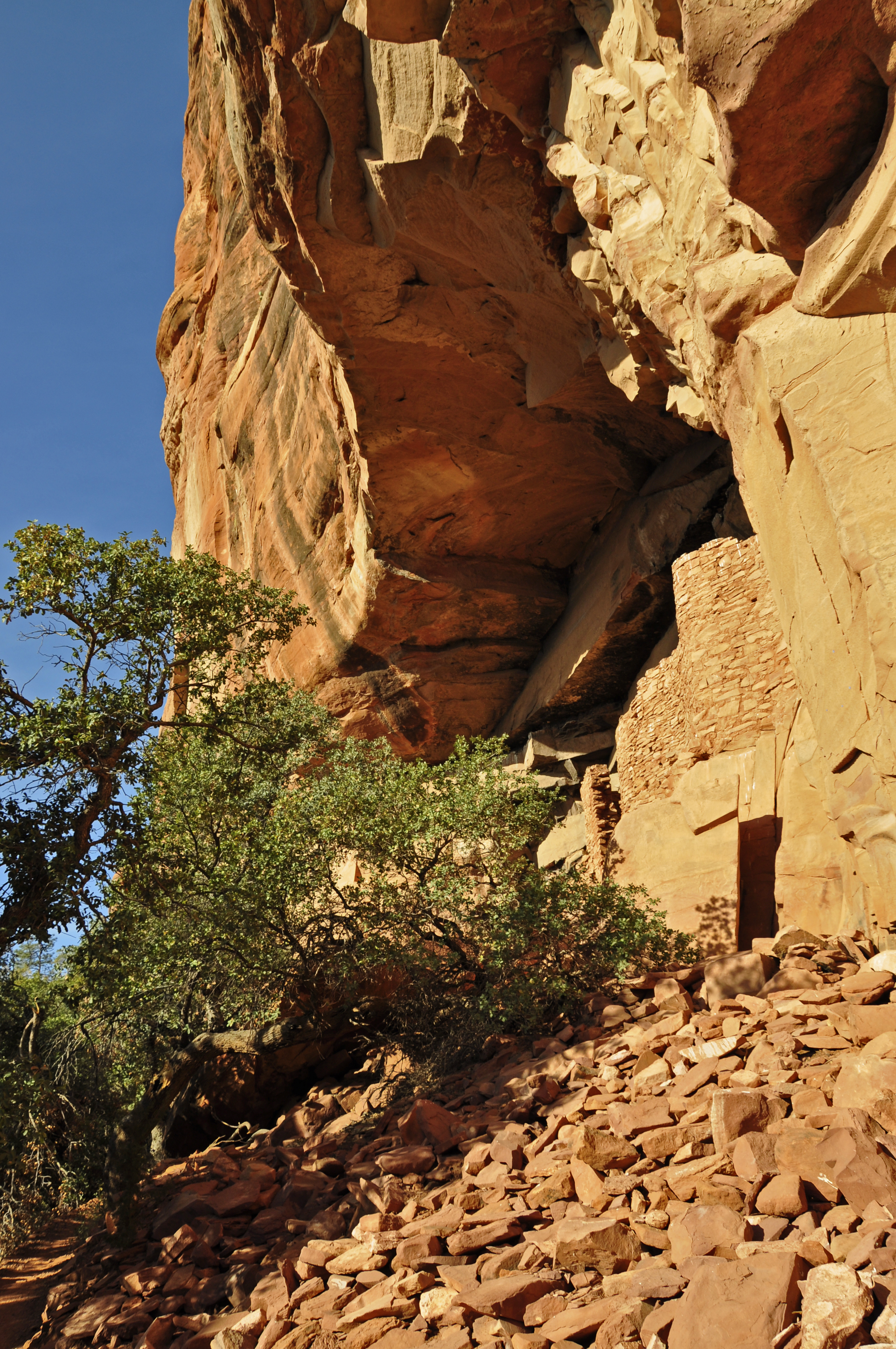|
Sinagua
The Sinagua were a pre-Columbian culture that occupied a large area in central Arizona from the Little Colorado River, near Flagstaff, Arizona, Flagstaff, to the Verde River, near Sedona, Arizona, Sedona, including the Verde Valley, area around San Francisco Mountain, and significant portions of the Mogollon Rim country, between approximately . Since fully developed Sinagua sites emerged in central Arizona around 650 CE, it is believed they migrated from east-central Arizona, possibly emerging from the Mogollon culture. Name The name ''Sinagua'' was coined in 1939 by archaeologist Harold S. Colton,Gibbon 770 founder of the Museum of Northern Arizona, from the Spanish words ''sin'' meaning "without" and ''agua'' meaning "water", referring to the name originally given by Spanish explorers to the San Francisco Peaks near Flagstaff, the "Sierra Sin Agua". The name reflects the surprise the Spanish felt that such large mountains did not have perennial rivers flowing from them, as is ... [...More Info...] [...Related Items...] OR: [Wikipedia] [Google] [Baidu] |
Montezuma Castle National Monument
Montezuma Castle National Monument protects a set of well-preserved dwellings located in Camp Verde, Arizona, which were built and used by the Sinagua people, a pre-Columbian culture closely related to the Hohokam and other Prehistoric Southwestern cultural divisions, indigenous peoples of the southwestern United States, between approximately AD 1100 and 1425. The main structure comprises five stories and about 20 rooms and was built over the course of three centuries. Several Hopi clans and Yavapai people, Yavapai communities trace their ancestries to early immigrants from the Montezuma Castle/Beaver Creek area. Archaeological evidence proves that the Hohokam and Hakataya settled around or in the Verde Valley. Clan members periodically return to these ancestral homes for religious ceremonies. Etymology Neither part of the monument's name is correct. When European-Americans first observed the ruins in the 1860s, by then long-abandoned, they named them for the famous Aztec emper ... [...More Info...] [...Related Items...] OR: [Wikipedia] [Google] [Baidu] |
Walnut Canyon National Monument
Walnut Canyon National Monument (Hopi language, Hopi: Wupatupqa) is a United States National Monument located about southeast of downtown Flagstaff, Arizona, near Interstate 40. The canyon rim elevation is ; the canyon's floor is lower. A long loop trail descends into the canyon passing 25 cliff dwelling rooms constructed by the Sinagua, a pre-Columbian cultural group that lived in Walnut Canyon from about 1100 to 1250 AD. Other contemporary habitations of the Sinagua people are preserved in the nearby Tuzigoot National Monument, Tuzigoot and Montezuma Castle National Monument, Montezuma Castle national monuments. History Sinagua is Spanish for "without water", an acknowledgement that the Sinagua people were able to live in such a dry region. By living in such a region the Sinagua became experts at conserving water and dealing with droughts. The Sinagua were also believed to have been active traders whose activities and influence stretched to the Gulf of Mexico and even ... [...More Info...] [...Related Items...] OR: [Wikipedia] [Google] [Baidu] |
Flagstaff, Arizona
Flagstaff ( ), known locally as Flag, is the county seat of Coconino County, Arizona, in the southwestern United States. As of the 2020 United States census, the city's population was 76,831. Flagstaff is the principal city of the Coconino County, Arizona, Flagstaff metropolitan area, which includes all of Coconino County, Arizona, Coconino County, and has a population of 145,101. Flagstaff lies near the southwestern edge of the Colorado Plateau and within the San Francisco volcanic field, along the western side of the largest contiguous Pinus ponderosa, ponderosa pine forest in the continental United States. The city sits at around and is next to Mount Elden, just south of the San Francisco Peaks, the highest mountain range in the state of Arizona. Humphreys Peak, the highest point in Arizona at , is about north of Flagstaff in Kachina Peaks Wilderness. The geology of the area includes exposed rock from the Mesozoic and Paleozoic eras, with Moenkopi Formation red sandstone ha ... [...More Info...] [...Related Items...] OR: [Wikipedia] [Google] [Baidu] |
Palatki
The Palatki Heritage Site is an archaeological site and park located in the Coconino National Forest, near Sedona, in Arizona, United States at approximately 34°54′56″N 111°54′08″W. In the Hopi language ''Palatki'' means 'red house'. History ;Cliff dwellings The Palatki site has a set of ancient cliff dwellings in the red sandstone cliffs, built from 1100 to 1400 CE by the Sinagua people of the Ancestral Puebloans. The cliff dwellings were built under south-facing overhangs for shelter and winter sun. The Sinagua people planted crops and made pottery in the area. Palatki and Honanki, another nearby archaeological site, had the largest cliff dwellings in the Red Rock formation area from . Palatki consists of two separate pueblos, suggesting two family or kin groups may have lived here, one in each pueblo. The circular shield-like pictographs above the eastern pueblo have been interpreted by some archaeologists as being a kin or clan symbol. [...More Info...] [...Related Items...] OR: [Wikipedia] [Google] [Baidu] |
Montezuma Well
Montezuma Well (), a detached unit of Montezuma Castle National Monument, is a natural limestone sinkhole near the town of Rimrock, Arizona, through which some of water emerge each day from an spring (hydrology), underground spring. It is located about northeast of Montezuma Castle. The "well" measures in diameter from rim to rim and contains a near-constant volume of spring water even in times of severe drought. The water is highly carbon dioxide, carbonated and contains high levels of arsenic. At least five endemic species, the most of any spring in the southwestern United States, are found exclusively in Montezuma Well: a diatom, the Montezuma Well springsnail, a Ranatra montezuma, water scorpion, the ''Hyalella montezuma'' amphipod, and the ''Motobdella montezuma'' leech. Montezuma Well's steady outflow has been used for irrigation since the 8th century. Part of a prehistoric irrigation ditch is preserved near the park's picnic ground, and portions of the ditch's orig ... [...More Info...] [...Related Items...] OR: [Wikipedia] [Google] [Baidu] |
Honanki
The Honanki Heritage Site is a cliff dwelling and rock art site located in the Coconino National Forest, about west of Sedona, Arizona. The Sinagua people of the Ancestral Puebloans, and ancestors of the Hopi people, lived here from about . The Palatki Heritage Site is nearby, also in the Coconino National Forest. History ;Ancient peoples The Honanki and Palatki archaeological sites were first studied by Jesse Walter Fewkes of the Smithsonian Institution. He conducted test excavations at both sites in 1895 and in 1911, during his study of Hopi migration traditions. Fewkes named the site "Honanki," which means "Bear House" in the Hopi language. Honanki was one of the largest prehistoric pueblos in the Verde Valley. This period in Southern Sinagua prehistory is called the "Honanki Phase." Many of the cliff dwellings in the area west of Sedona were occupied during the Honanki Phase. The Sinagua occupation of Honanki was probably between 1130 and 1280 CE, based on a tree-ring ... [...More Info...] [...Related Items...] OR: [Wikipedia] [Google] [Baidu] |
Elden Pueblo
Elden Pueblo (Hopi language, Hopi: Pasiwvi) was a prehistoric Indigenous peoples of the Americas, Native American village at the foot of Mount Elden near Flagstaff, Arizona. The pueblo is considered part of a major trading system.Elden Pueblo Archaeological Site at Coconino National Forest Various trade items, such as macaw skeletons from Mexico and shell jewelry from the coast of California, have been found throughout the site. The area is now protected and is used for research and educational purposes. History The area was settled by the Sinagua people from approximately 1070 to 1275. The site was believed to be home to 200–300 people within 60–70 rooms. Aside from the structures constructed of compacted stones, a burial moun ...[...More Info...] [...Related Items...] OR: [Wikipedia] [Google] [Baidu] |
Pre-Columbian
In the history of the Americas, the pre-Columbian era, also known as the pre-contact era, or as the pre-Cabraline era specifically in Brazil, spans from the initial peopling of the Americas in the Upper Paleolithic to the onset of European colonization of the Americas, European colonization, which began with Christopher Columbus's voyage in 1492. This era encompasses the history of Indigenous peoples of the Americas, Indigenous cultures prior to significant European influence, which in some cases did not occur until decades or even centuries after Columbus's arrival. During the pre-Columbian era, many civilizations developed permanent settlements, cities, agricultural practices, civic and monumental architecture, major Earthworks (archaeology), earthworks, and Complex society, complex societal hierarchies. Some of these civilizations had declined by the time of the establishment of the first permanent European colonies, around the late 16th to early 17th centuries, and are know ... [...More Info...] [...Related Items...] OR: [Wikipedia] [Google] [Baidu] |
V Bar V Heritage Site
The Crane Petroglyph Heritage Site is the largest known petroglyph site in the Verde Valley of central Arizona, and one of the best-preserved. The rock art site consists of 1,032 petroglyphs in 13 panels. Acquired by the Coconino National Forest in 1994, the site is protected and kept open to the public by the US Forest Service. Volunteers from the Verde Valley Archaeological Society and the Friends of the Forest provide interpretive tours and on-site management. A visitor center, restroom and bookstore, operated by the Forest Service and the Arizona Natural History Association, is located on site. The fenced petroglyph site is an easy half-mile walk from the parking lot. For most of the year, there is a resident on-site custodian. History The petroglyphs were created by Southern Sinagua residents between about 1150 and 1400 AD. The site was known to early American settlers, and became part of a cattle ranch around the turn of the 20th century. Some historic ranch buildings r ... [...More Info...] [...Related Items...] OR: [Wikipedia] [Google] [Baidu] |
Tuzigoot
Tuzigoot National Monument (, Western Apache: ''Tú Digiz'') preserves a 2- to 3-story pueblo ruin on the summit of a limestone and sandstone ridge just east of Clarkdale, Arizona, above the Verde River floodplain. The Tuzigoot Site is an elongated complex of stone masonry rooms that were built along the spine of a natural outcrop in the Verde Valley. The central rooms stand higher than the others and they appear to have served public functions. The pueblo has 110 rooms. The National Park Service currently administers , within an authorized boundary of . ″Tú Digiz/Tuzigoot″ is a Tonto Apache term for "crooked waters," from nearby Pecks Lake, a cutoff meander of the Verde River; from Tú Digiz one principal Tonto Apache clan gets its name. The pueblo was built by the Sinagua people between 1125 and 1400 CE. Tuzigoot is the largest and best preserved of the many Sinagua pueblo ruins in the Verde Valley. The ruins at Tuzigoot incorporate very few doors; instead, the inhabitant ... [...More Info...] [...Related Items...] OR: [Wikipedia] [Google] [Baidu] |
Wupatki National Monument
The Wupatki National Monument is a United States National Monument located in north-central Arizona, near Flagstaff. Rich in Native American archaeological sites, the monument is administered by the National Park Service in close conjunction with the nearby Sunset Crater Volcano National Monument. Wupatki was established as a national monument in 1924 and was listed on the National Register of Historic Places on October 15, 1966. The listing included three contributing buildings and 29 contributing structures on . History The many settlement sites scattered throughout the monument were built by the Ancient Pueblo People, more specifically the Cohonina, Kayenta, and Sinagua. Wupatki, which means "Long Cut House" in the Hopi language, is a multistory pueblo dwelling comprising over 100 rooms and a community room and the northernmost ballcourt ever discovered in North America, creating the largest building site for nearly 50 miles. Nearby secondary structures have also been u ... [...More Info...] [...Related Items...] OR: [Wikipedia] [Google] [Baidu] |









